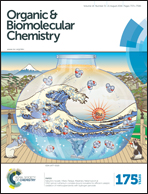Complexation of clofazimine by macrocyclic cucurbit[7]uril reduced its cardiotoxicity without affecting the antimycobacterial efficacy†
Abstract
Cucurbit[7]uril (CB[7]) has recently attracted increasing attention in pharmaceutical sciences due to its great potential in improving the physicochemical properties and bioactivity of drug molecules. Herein, we have investigated the influence of CB[7]'s complexation on the solubility, antimycobacterial activity, and cardiotoxicity of a model anti-tuberculosis drug, clofazimine (CFZ), that has poor water-solubility and inherent cardiotoxicity. In our study, CFZ was found to be complexed by CB[7], in a 1 : 1 binding mode with a relatively strong binding affinity (in the order of magnitude of 104–105 M−1), as determined by the phase solubility method via HPLC-UV analysis and 1H NMR titration, as well as UV-visible spectroscopic titration, and further confirmed by electrospray ionization mass spectrometry (ESI-MS). Upon complexation, the solubility of virtually insoluble CFZ was significantly increased, reaching a concentration of up to approximately 0.53-fold of the maximum solubility of CB[7]. The inherent cardiotoxicity of CFZ was dramatically reduced to almost nil in the presence of CB[7]. Importantly, on the other hand, such a supramolecular complexation of the drug did not compromise its therapeutic efficacy, as shown by the antimycobacterial activities examined against Mycobacterium smegmatis, demonstrating the significant potential of CB[7] as a functional pharmaceutical excipient.
![Graphical abstract: Complexation of clofazimine by macrocyclic cucurbit[7]uril reduced its cardiotoxicity without affecting the antimycobacterial efficacy](/en/Image/Get?imageInfo.ImageType=GA&imageInfo.ImageIdentifier.ManuscriptID=C6OB01060A&imageInfo.ImageIdentifier.Year=2016)


 Please wait while we load your content...
Please wait while we load your content...